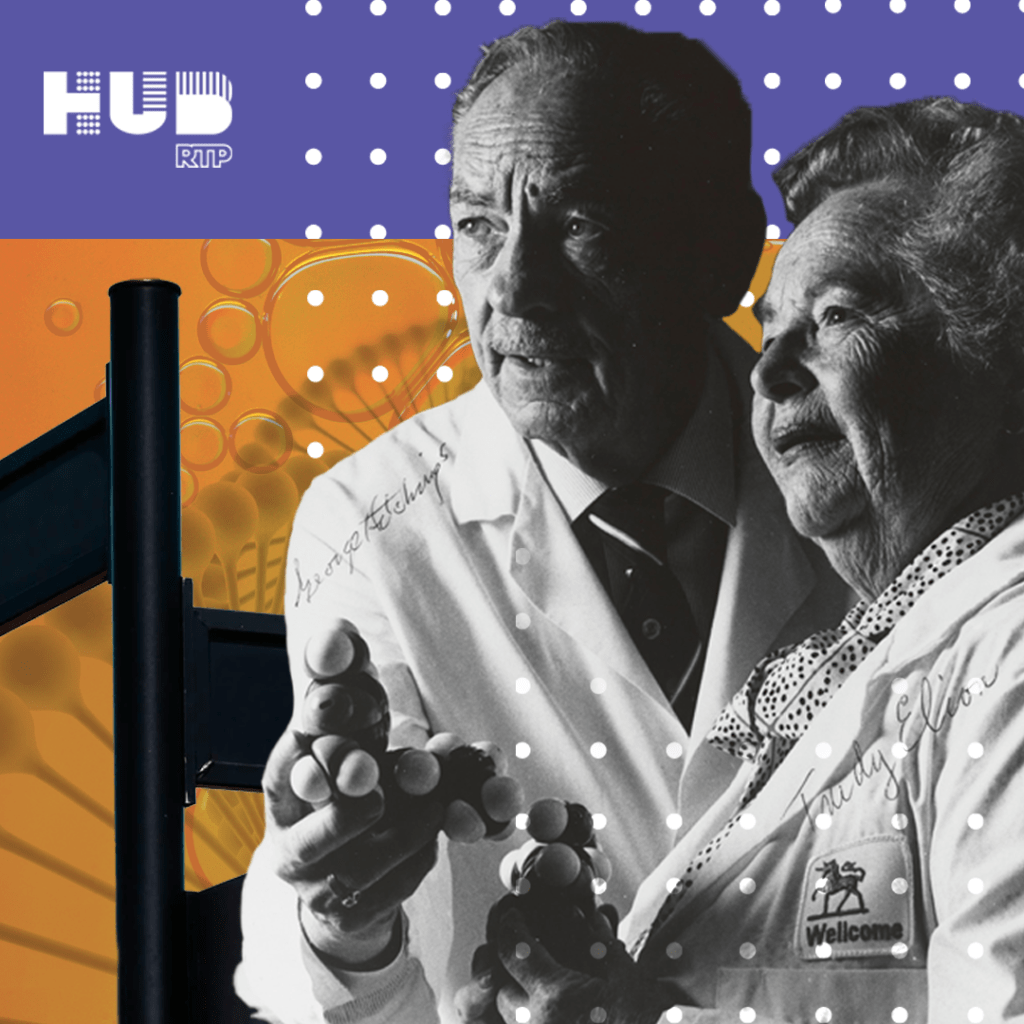
The stories behind Hub RTP’s street names represent the creative collision embedded in the ideals Research Triangle Park was founded upon. Each street was named for a Nobel-awarded scientist whose collective discoveries paved the way for continued growth in the Park and the Triangle Region while offering advancements to the science and medical research community.
Elion Drive and Hitchings Way, which intersect in Hub RTP’s retail and residential district, are named after Gertrude B. Elion and Dr. George H. Hitchings, health science teammates who began their groundbreaking research in 1944 at the U.S. headquarters of Burroughs Wellcome in Tuckahoe, New York and later, Research Triangle Park. The pair was recognized with the Nobel Prize in Physiology or Medicine in 1988 after a professional partnership of nearly 40 years. If Burroughs Wellcome sounds familiar, you may have heard of the private, charitable fund by the same name.
Gertrude Elion pushed the boundaries for American women in science when she began her studies in chemistry in the 1930s, a time when most women did not pursue education beyond high school. Her passion for health sciences grew out of the loss of her beloved grandfather to stomach cancer while she was in her teens. After graduating from Hunter College, she sought a way to fund the next steps of her education. Due to gender discrimination, most graduate study grants and fellowships were awarded to men. Undaunted by societal limitations, Elion saved enough money to enroll as a graduate student at New York University by working secretarial jobs and teaching biochemistry to nurses at NYU, where she became connected with a chemist who hired her as a lab assistant. While completing her master of science degree, she taught chemistry and physics in New York City public schools.
After Elion graduated in 1941, she found that the job market had shifted in her favor; many men in the U.S. were drafted during World War II, which led to more variety in job opportunities for educated women. Elion’s first full-time lab job was in A & P grocery’s food quality department, which quickly became too repetitive for her interests. An employment agency placed her in a limited assignment at Johnson & Johnson and then connected her with the opportunity that began her health sciences career with long-time collaborator, George Hitchings.
Dr. George Hitchings was motivated to pursue medical science by similar circumstances; his father passed away after a long illness when Hitchings was a boy. He began as a determined premedical student at the University of Washington in Seattle, but soon became enthralled with chemistry and changed direction in his course of study. After earning his Ph.D., Hitchings devoted his early career to cancer research and public health at his alma mater, Harvard Medical School, before joining the Biochemistry Department at Wellcome Research Laboratories in Tuckahoe, New York. The company would continue to grow over the years and move to Research Triangle Park in 1970, eventually merging with other pharmaceutical conglomerates and known today as GlaxoSmithKline.
The discovery and development methods originated by Elion and Hitchings have remained as standard procedure in the pharmaceutical industry.
The Nobel Prize recognized the pair’s radical departure from the trial-and-error approach that had been typical in the pharmaceutical industry at the start of their collaboration. They experimented with new ways to treat conditions such as leukemia, malaria, infection and gout by the reactions of healthy human cells compared with cancer cells and noxious organisms to the introduction of substances that could block growth of the invasive cells and disease. This research also let to Elion’s discovery of azathioprine, an immunosuppresive drug that can prevent organ rejection, especially in patients with compromised immune systems.
According to the Science History Institute, Elion’s and Hitching’s methods were based on the principle of “deliberately designing new molecules with specific molecular structures, using what today is termed rational drug design.” Their insightful approach to medicine based on normal cell functions made a permanent impact on standard practices in the drug development industry.
Based on the way acyclovir, an anti-viral drug, was developed, their team applied a similar process to create the AIDS drug, azisothymidine (AZT), which was approved by the FDA in 1987. The discovery and development methods originated by Elion and Hitchings have remained as standard procedure in the pharmaceutical industry and the success of acyclovir in particular had a strong influence on the creation of other antivirals including those to treat coronavirus patients.
Who are the life sciences disruptors of our time? You might meet them while waiting for your lunch order at Boxyard RTP, at an #RTP180 event or while walking on the trails that weave through our research park. Hub RTP will create even more opportunities to connect and learn from the people and companies that call Research Triangle Park home.
Check out these resources to learn more about Gertrude B. Elion’s work:
Check out these resources to learn more about Dr. George H. Hitching’s work: